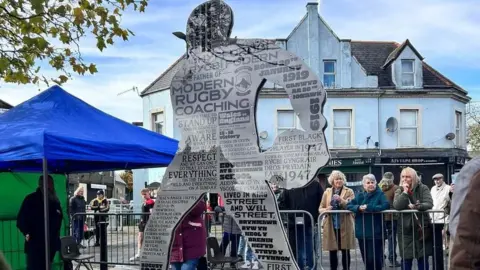Roy Francis monument honours black rugby league pioneer
 Jules Gardner
Jules GardnerA monument has been put up in honour of a rugby league pioneer in his south Wales home town.
Roy Francis appears to have been largely forgotten, yet he led the way as a player and coach.
He was the first black man to play for Great Britain, as well as the first black head coach of a British top tier professional team.
That gave him authority over white men at a time when that would have been unthinkable in other areas of society.
The monument was unveiled in Brynmawr in Blaenau Gwent, with family members and former players present to pay tribute to his memory.
Among those there on Saturday was Jonathan Davies, the former rugby union and league international.
"I think the story more or less went to sleep rather than anything else," said Ian Haywood, founder of the project behind it.
"But there's been so much research done recently that the story gets bigger and bigger, and the more I found out about it, it's become more special."
"The thing is about Roy Francis is that he was just the first of doing so many things against a lot of problems, especially racism problems."
Who was Roy Francis?
He was born in 1919, and played rugby union for Brynmawr before switching codes and playing rugby league for Wigan in 1936.
He joined Barrow in 1939, and served as a physical training instructor in the north of England during World War Two.
 Jules Gardner
Jules GardnerHe became the first black man to play for Great Britain in 1947, and stopped playing in 1955.
After his playing career, he coached Hull to the Championship title in 1956 and 1958, and Leeds to the Challenge Cup in 1968.
After a spell coaching in Australia, he returned to Leeds and won the Premiership in 1974.
He retired in 1977, and died in 1989.
 Hull FC
Hull FCAfter initially playing rugby union for Brynmawr RFC, at 17 he became one of the first black rugby league players when he switched codes to join Wigan.
He found some success there and then at Barrow, where after the war his form saw him called up to the Great Britain squad. In 1947 he became the first black man to play for Great Britain, scoring two tries against New Zealand.
He ended his playing career with a remarkable record of 229 tries in 356 games.
"He would have probably played more," said Mr Haywood. "The only problem was in between Barrow, World War Two came up, so that sort of finished things off for 5 years in a lot of respects".
"But then to his advantage he was in the Army, and his job was to rehabilitate soldiers to get them back into fighting fitness. This sort of led onto his coaching techniques."
 Jules Gardner
Jules GardnerIf his playing career impressed, his coaching career influenced, winning trophies with Hull and Leeds by using techniques well ahead of his time.
"He used to film games and training sessions so players could see what they were doing right or wrong," said Mr Haywood.
"They've got drones now flying around on training pitches, which obviously started with Roy with his Sydney camera."
"There were also individual diets for players, and he'd tell them they needed to eat different food. He'd even take him into his own house to make sure they did it."
More than 30 years on from his death, it is only recently that Francis has started to get properly recognised.
In 2018 he was inducted into the Welsh Sports Hall of Fame, and now comes the Brynmawr monument. It follows the unveiling of a statue of fellow Welsh, black, rugby league players Billy Boston and Clive Sullivan - along with Gus Risman - in Cardiff.
For Mr Haywood, it's a story that can inspire future generations.
"With the monument being unveiled, the school kids growing up can look at what he did in his life. It can give them some ambition to be able to achieve things."
"It certainly makes people appreciate what people lived like then, and what happened.
"And it's nice that it's coming back to Wales."

- BEING LOUIS REES-ZAMMIT: Unfiltered access to rugby's new superstar
- LEGENDS OF WELSH SPORT: Some of the greatest and most inspiring stories in Welsh sport

